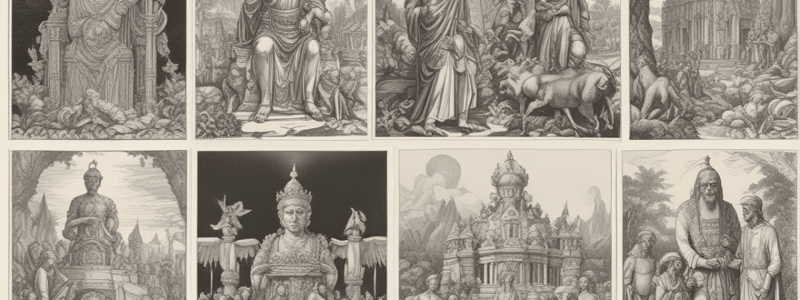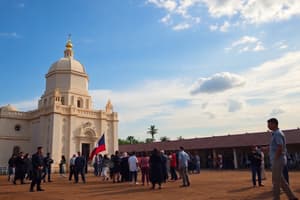Podcast
Questions and Answers
What was the purpose of the chapter discussed in the text?
What was the purpose of the chapter discussed in the text?
- To provide an overview of the different historical controversies in the Philippines (correct)
- To assess the contributions of historical texts and sources to Philippine History
- To analyze the First Mass in the Philippines
- To discuss the life of Antonio Pigafetta
Which of the following is NOT one of the specific objectives mentioned in the text?
Which of the following is NOT one of the specific objectives mentioned in the text?
- Determine the contribution of historical texts and source to the Philippine History
- Get a better grasp of complex challenges and consider different points of view
- Analyze the life and voyages of Antonio Pigafetta (correct)
- Demonstrate the ability to formulate arguments in favor or against a particular issue using the historical texts and sources
What is the duration mentioned for the assessment of the chapter on the First Mass in the Philippines?
What is the duration mentioned for the assessment of the chapter on the First Mass in the Philippines?
- 4 hours
- 1 hour
- 2 hours
- 3 hours (correct)
Who was Antonio Pigafetta?
Who was Antonio Pigafetta?
What is the main purpose of the translation of Antonio Pigafetta's work mentioned in the text?
What is the main purpose of the translation of Antonio Pigafetta's work mentioned in the text?
Which of the following is NOT one of the historical controversies mentioned in the text?
Which of the following is NOT one of the historical controversies mentioned in the text?
What is the main significance of Antonio Pigafetta's venture mentioned in the text?
What is the main significance of Antonio Pigafetta's venture mentioned in the text?
What was the condition of documents and contemporaneous testimonies about Antonio Pigafetta?
What was the condition of documents and contemporaneous testimonies about Antonio Pigafetta?
How did the people described in the text use stones according to their customs?
How did the people described in the text use stones according to their customs?
What initiated the custom of eating human flesh among the people described in the text?
What initiated the custom of eating human flesh among the people described in the text?
What distinctive feature is mentioned about the boats used by the people described in the text?
What distinctive feature is mentioned about the boats used by the people described in the text?
How did every individual in the community described in the text consume human flesh?
How did every individual in the community described in the text consume human flesh?
Study Notes
Antonio Pigafetta and the First Voyage Around the World
- Antonio Pigafetta was a key player in the first globe circumnavigation between 1519 and 1522.
- He accomplished the journey after the murder of Ferdinand Magellan and wrote a detailed description of the journey in the Report of the first trip around the world.
- The Report of the first trip around the world was a lost manuscript that was rescued later, in 1797, and is now considered one of the most important documentary evidences relating to the geographical discoveries of the Sixteenth Century.
The People of the Boii
- The people of the boii lived in long houses with cotton hammocks called amache.
- A fire was built on the ground under those hammocks.
- Each boii housed one hundred men with their wives and children, and they made a great racket.
- They had boats called canoes made of one single huge tree, hollowed out by the use of stone hatchets.
- They employed stones as we do iron, as they had no iron.
- Thirty or forty men occupied one of those boats.
The People's Customs and Practices
- The people ate the human flesh of their enemies, not because it was good, but because it was a certain established custom.
- The custom, which is mutual, was begun by an old woman, who had but one son who was killed by his enemies.
- The people would cut off a piece of the human flesh, smoke it, and then eat it with their other food.
Philippine History Chapter 4: The Different Historical Controversies
- The chapter discusses different historical controversies, including the First Mass in the Philippines, the Cavite Mutiny, and the Pugadlawin, Balintawak or Bahay Toro.
- The chapter aims to help students learn about important themes, get a better grasp of complex challenges, and consider different points of view.
- Students will be able to demonstrate the ability to formulate arguments in favor or against a particular issue using historical texts and sources.
Studying That Suits You
Use AI to generate personalized quizzes and flashcards to suit your learning preferences.
Description
Test your knowledge on the different historical controversies discussed in Chapter 4 of Philippine History, including The First Mass in the Philippines, the Cavite Mutiny, and Pugadlawin, Balintawak or Bahay Toro. This quiz will help students understand key themes, navigate complex challenges, and explore various perspectives.




